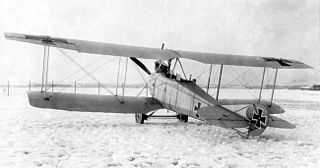
The Albatros C.III was a twin-seat general-purpose biplane designed and produced by the German aircraft manufacturer Albatros Flugzeugwerke. It was produced in greater numbers than any other C-type aircraft by Albatros as well as being the company's most-produced twin-seat aircraft.

The Albatros C.I,, was a twin-seat general-purpose biplanes designed and produced by the German aircraft manufacturer Albatros Flugzeugwerke. It was the first of the successful C-series aircraft operated by the Luftstreitkräfte.

The Albatros B.II, was an unarmed two-seat reconnaissance biplane designed and produced by the German aircraft manufacturer Albatros Flugzeugwerke. It was the aircraft that brought Albatros Flugzeugwerke to the world's attention.

The Albatros D.III was a biplane fighter aircraft used by the Imperial German Army Air Service during World War I. A modified licensed version was built by Oeffag for the Austro-Hungarian Air Service (Luftfahrtruppen). The D.III was flown by many top German aces, including Wilhelm Frankl, Erich Löwenhardt, Manfred von Richthofen, Karl Emil Schäfer, Ernst Udet, and Kurt Wolff, and Austro-Hungarians like Godwin von Brumowski. It was the preeminent fighter during the period of German aerial dominance known as "Bloody April" 1917.

The Aviatik C.I was an observation aircraft designed and produced by the German aircraft manufacturer Aviatik. It was the first aircraft produced by the company to be mass-produced as well as one of the first German military aircraft of the First World War to become fairly well known amongst the general public of the era.

The Albatros D.I was an early fighter aircraft designed and produced by the German aircraft manufacturer Albatros Flugzeugwerke. It was the first of the Albatros D types which equipped the majority of the German and Austrian fighter squadrons (Jagdstaffeln) for the last two years of the First World War. Despite this, the D.I had a relatively brief operational career, having been rapidly eclipsed by rapid advances in fighter aircraft.

The Albatros D.V is a fighter aircraft of the German aircraft manufacturer Albatros Flugzeugwerke. It was the final development of the Albatros D.I family and the last Albatros fighter to see operational service with the Luftstreitkräfte during the First World War.

The Pfalz D.III was a fighter aircraft used by the Luftstreitkräfte during the First World War. The D.III was the first major original design from Pfalz Flugzeugwerke. Though generally considered inferior to contemporary Albatros and Fokker fighters, the D.III was widely used by the Jagdstaffeln from late 1917 to mid-1918. It continued to serve as a training aircraft until the end of the war.

The Albatros W.4 was a military floatplane designed and produced by the German aircraft manufacturer Albatros Flugzeugwerke.

The Friedrichshafen G.III was a heavy bomber designed and manufactured by Flugzeugbau Friedrichshafen. They were used by the German Imperial Air Service during World War I for tactical and limited strategic bombing operations. After the end of the war a number of Friedrichshafen bombers were converted into transport aircraft while a small number also saw service as dedicated airliners.

The AGO C.IV was a German biplane reconnaissance aircraft designed and produced by the German aircraft manufacturer AGO Flugzeugwerke. It was active with the Luftstreitkräfte during the latter half of the First World War.

The Albatros C.V was a military reconnaissance aircraft designed and produced by the German aircraft manufacturer Albatros Flugzeugwerke.

The Albatros C.VII was a military reconnaissance aircraft designed and produced by the German aircraft manufacturer Albatros Flugzeugwerke. It was a revised and re-engined development of the Albatros C.V, which had proved disappointing in service.

The Albatros C.X was a military reconnaissance aircraft designed and produced by the German aircraft manufacturer Albatros Flugzeugwerke.

The Albatros J.I was an armored ground attack airplane designed and produced by the German aircraft manufacturer Albatros Flugzeugwerke. It saw active combat during the final months of the First World War.

The Hannover CL.III was a German military aircraft of World War I. It was a two-seat multi-role aircraft, primarily used as a ground attack machine. Like the other Hannover "light-C-class", or "CL" designated aircraft designed by Hermann Dorner, it included an unusual biplane tail, allowing for a greater firing arc for the tail gunner. Until the introduction of the aircraft, such tails had only been used on larger aircraft.

The Junkers J.I was a German "J-class" armored sesquiplane of World War I, developed for low-level ground attack, observation and army cooperation. It is especially noteworthy as being the first all-metal aircraft to enter mass production; the aircraft's metal construction and heavy armour was an effective shield against small arms fire over the battlefield.

The Rumpler D.I was a fighter-reconnaissance aircraft produced in Germany at the end of World War I. It was a conventional single-bay biplane with wings of unequal span braced by I-struts. It featured an open cockpit and a fixed, tailskid undercarriage. The upper wing was fitted with aerodynamically balanced ailerons and fuselage had an oval cross-section.

The Zeppelin-Staaken Riesenflugzeuge were a series of very large bomber aircraft - Riesenflugzeuge, usually powered by four or more engines, designed and built in Germany from 1915 to 1919.

The Zeppelin-Lindau Rs.II was a biplane flying boat, designed by Claudius Dornier as a follow-on to his Zeppelin-Lindau Rs.I and built during 1914–1915 on the German side of Lake Constance. Initially this aircraft was powered by three engines mounted inside the hull driving three pusher propellers via gearboxes and shafts. The later version was powered by four engines in two push-pull nacelles mounted between the wings.





















